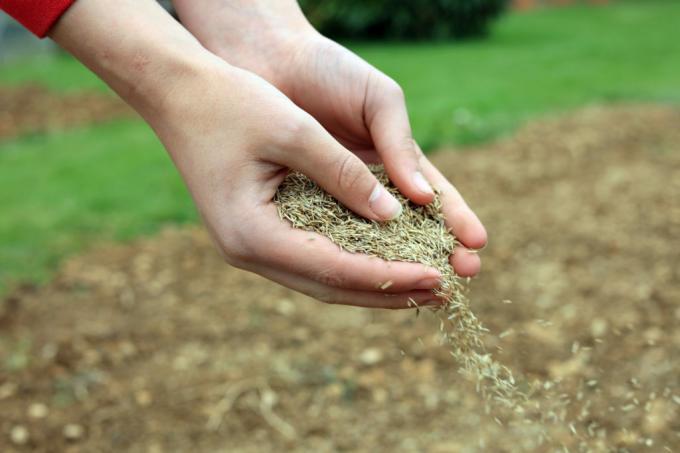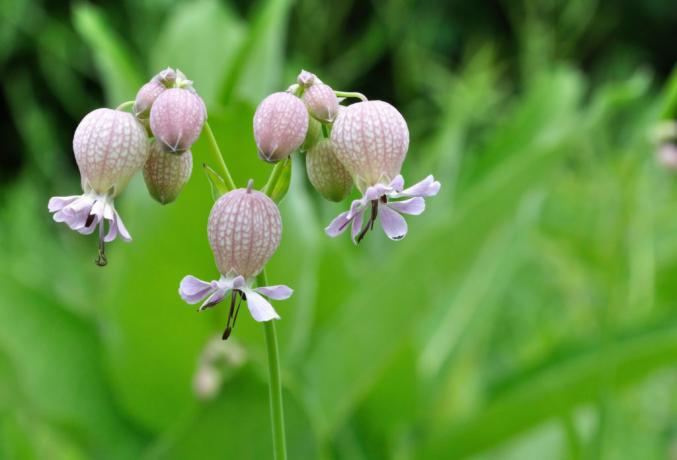More and more people decide against a lawn and for a flower meadow. Here we show the advantages of a flower meadow and how to create it.

Well-groomed, almost meticulously trimmed race was to be found in almost every garden for a long time. Gardeners in particular with a large plot of land could hardly avoid laying out large lawns if they did not want to use gravel beds or paved areas. But now there is an alternative that is becoming more and more popular: actually decide More and more gardening enthusiasts are opposed to the standardised, short-cut lawn and are in favor of a colorful one flower meadow. This not only looks good, but also has numerous advantages over a normal lawn. Here you can find out what is behind it and how you can create a flower meadow in your own garden.
contents
- What are the advantages of flower meadows?
-
How to create a flower meadow
- Variant 1: Create lean meadow slowly
- Variant 2: Create lean meadow quickly
- Variant 3: Create a flower meadow to match the location
-
The best plants for your flower meadow
- The best plants for a lean meadow
- The best plants for a fat meadow
Accurate, green lawn or a wild, colorful sea of flowers? Recently, flower meadows can be found in more and more gardens and not only cause enthusiasm because of their appearance.
What are the advantages of flower meadows?
Mowing, aerating, scarifying - a lawn like this is a lot of work if you want it to look nice and green and fresh for years to come. In fact, the amount of work and time involved in lawn care is one of the most common reasons gardeners switch to a flower meadow. In contrast to the lawn, this is namely particularly easy to care for: Once a year (preferably from the end of July to mid-August) the flower meadow must be mowed so that the annual wild plants can spread their mature seeds over the area. Otherwise, the flower meadow hardly needs any care.
But that is not their only advantage - almost as important as the lower workload is the fact that a flower meadow represents a much better biotope than a simple lawn. Particularly rare wild bees, but also bumblebees, butterflies or the hedgehog find a suitable home in a flower meadow and are thus protected. But native wild flowers, which often no longer find a habitat between gardens and agriculture, can also thrive on the flower meadow. A simple flower meadow contributes to the preservation of biodiversity - on the lawn, on the other hand, only a few insects can survive and even wild herbs have almost no chance here.

Plantura butterfly meeting
Annual & perennial species for butterflies
lings & their caterpillars, easier to care for
Blossom dream in bed, pot & window box
Of course, the flower meadow also impresses with its visual charms: Against the romantic charm and the enchanting play of colors of the blooming wildflowers comes simple lawn simply not on.

How to create a flower meadow
Even if a flower meadow is easy to care for, the creation of such a natural space in the garden is unfortunately not child's play. In fact, it's not enough to just sow a few wildflower seeds and stop mowing the lawn if you want to see a sea of flowers next year. The main reason for this is the soil: while a green, healthy lawn needs nutrient-rich soil, the popular lean meadow in particular needs sandy, nutrient-poor soil. In order for the flower meadow project to succeed, a little time and patience is therefore necessary. There are a total of three ways to transform a lawn into a flower paradise, which we would like to briefly introduce to you below.
Variant 1: Create lean meadow slowly
With the slow, but less complex variant, you stop and stop fertilizing the lawn changes the cut to a few times a year (the clippings should always be carefully removed will). The nutrient content in the soil decreases over the years and there is an immigration of typical meadow herbs and flowers from the immediate vicinity. Anyone who, due to a rather urban environment, cannot hope for wild plants to sprout or would like certain flowering plants in their meadow can also "vaccinate" the lawn. The lawn is selectively removed and flowering plants are sown in a targeted manner or herbs that have been grown are planted in these areas. Over time, these spread over the entire lawn and create a flower meadow. It goes a little faster if you scarify the lawn very vigorously in autumn or early spring and instead of new grass seed a wild plant mixture is sown. However, the development to a complete, healthy flower meadow can also take place here in several ways Lasts for years and is particularly successful in gardens that already have sandy soil crowned.
Variant 2: Create lean meadow quickly
The second method is faster, but at the same time more complex. The entire turf is removed here. Now the top 10 to 20 centimeters of the soil (depending on the type of soil) are either removed and covered with sandy soil Soil replaced or loosened and mixed with sand to create nutrient-poor, well-drained soil generated. In particularly wet locations, additional drainage can be useful. The soil is now allowed to settle for about two days before you can start sowing the flower mixture. The best time to create a flower meadow is spring or autumn. Be careful not to spread too many seeds in one area (one to a maximum of five grams of seeds per square meter) and then gently rake in the seeds flat. The seeds are also gently pressed to the ground with a lawn roller. After sowing, the meadow should be watered regularly. In addition, you should not enter the meadow after the first plants have germinated, as wild flowers can react sensitively to it.

Variant 3: Create a flower meadow to match the location
Even though the rough meadow is probably the most well-known and also the most diverse type of meadow, it is by far not the only flower meadow that can be created in a garden. In fact, there are wild flowers and herbs that match almost every type of soil, with which you can set up a wild flower meadow. A soil analysis, which you can commission from various institutions, provides information about the type of soil. Based on this soil analysis, the meadow mixtures or individual flowers can now be selected that should thrive on the natural soil type. But garden owners don't have to be ashamed if they "only" sow a fat meadow adapted to their soil instead of a poor meadow - also this form of flower meadow has now become rather rare in Germany and has a special character with its blooming residents Charm.

The best plants for your flower meadow
Depending on whether you want to create a lean meadow or a fat meadow in your garden, different plants are best suited.
The best plants for a lean meadow
Colorful and rich in species - this is how rough meadows present themselves in nature. But which plants fit best on the newly created flower meadow? Striking flowering plants such as meadow sage (Salvia pratensis) and the thrift (Armeria maritima) or tried and true classics like that cornflower (Centaurea cyanus) and the poppy (Papaver rhoeas). But also rather unknown wild plants such as the black mullein (Verbascum nigrum) or pigeon scabious (Scabiosa columbaria) exude their charm impressively. In addition, grasses such as the common trembling grass (brizamedia) and sedum-Species (sedum) for a coherent overall picture.

The best plants for a fat meadow
If you want to create a fat meadow, you should rely on other plants. Among the grasses that thrive particularly well in a rich meadow are the orchard grass (Dactylis glomerata), but also smooth oats (Arrhenaterum elatius) and crested grass (Cynosurus cristatus). In addition to the numerous types of grass, however, three types in particular are typical of a fat meadow: daisies (Bellis perennis), dandelion (Taraxacum) as well as clover (trifolium). In addition, other plants such as yarrow (Achillea) with its numerous small flowers and the buttercup known as buttercup (Ranunculus) gladly represented on the fat meadow. But also other colorful bloomers like the meadow daisy (Leucanthemum vulgare), the scabious (Knautia) or the pigeon campion (Silene vulgaris) impress in the Fettwiese with their blooms and transform your garden into a feast for the eyes.

tip: A good way to create flower meadows is to use ready-made seed mixes, as these all include the required plant seeds and the customer thus has to laboriously collect the various plants spare In the meantime, numerous traders are offering such meadow mixtures, which contain native species with similar site conditions for the various meadow types. But be careful: So-called "show mixtures" that are offered for flower meadows are often special floriferous, but contain exotic flowers that cannot prevail in our garden in the long term.
If you are further interested in natural and environmentally friendly gardening, you will find our article on this here natural garden. An alternative to protecting beneficial insects is also provided by beneficial insect hotels such as butterfly houses.
...and receive concentrated plant knowledge and inspiration directly in your e-mail inbox every Sunday!



